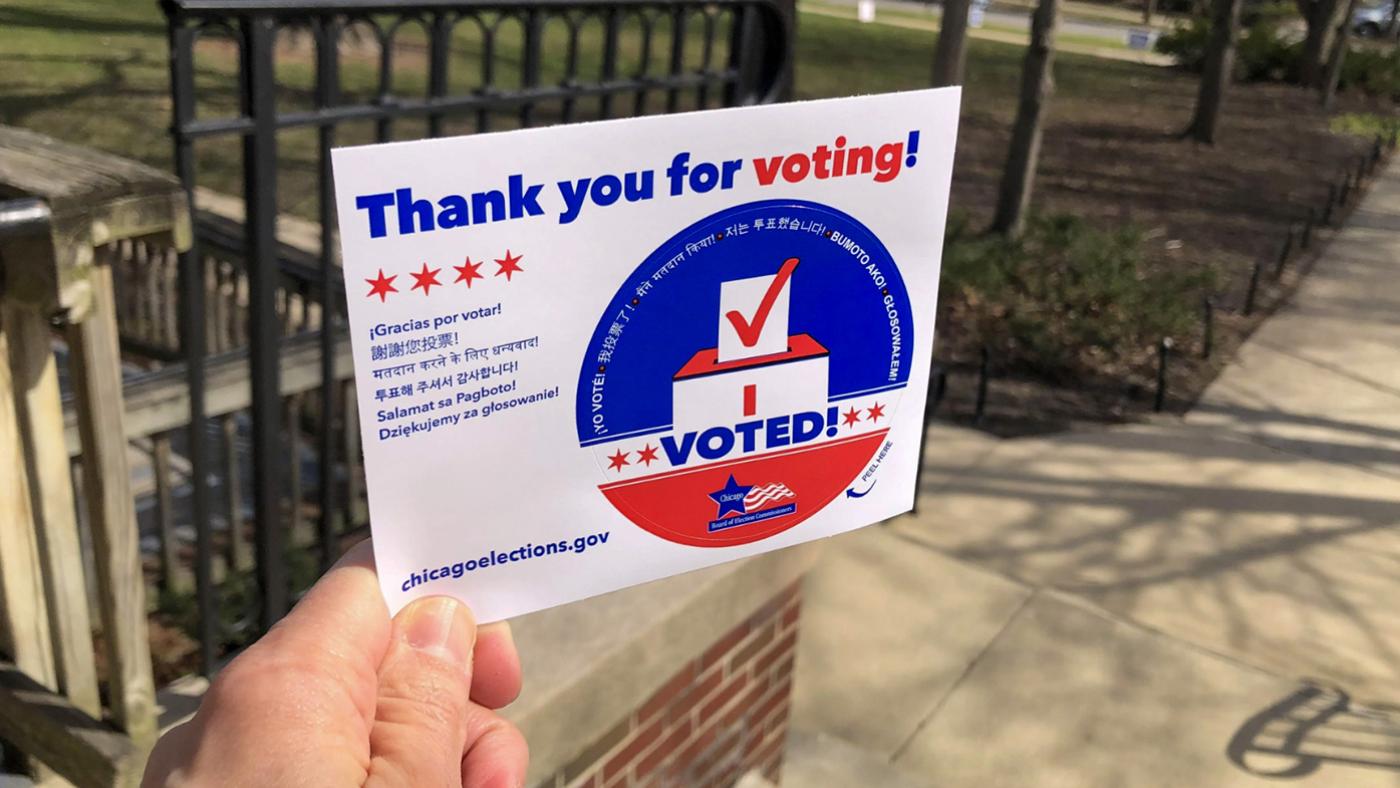A Brief Introduction to Sikhism
Daniel Hautzinger
May 5, 2021

Fifty years ago, Rajinder Singh Mago arrived in the United States from his native Punjab. Just out of college, he first stayed in Cincinnati before moving to Chicago in 1972—just in time to see the Sikh community in Chicago begin to set down roots. That year, the Sikh Religious Society, formed in 1956 by students at the University of Chicago, bought land in northwest suburban Palatine. Seven years later on that land, they held their first services in their new gurdwara, a gathering and worship space that houses the Sikh scripture, the Guru Granth Sahib. It was Chicagoland’s first gurdwara. Nowadays, in non-COVID times, two thousand people might attend a service.
Despite its relatively recent arrival in Chicago, Sikhism is the world’s fifth-largest religion, with 25 to 30 million adherents around the globe and an estimated 500,000 in America today. It was founded in the Punjab region, in what is now northwest India and central Pakistan, by Guru Nanak, who was born in 1469. (The majority of Sikhs still live in Indian Punjab.)
“At the time there was a lot of conflict between Hindus and Muslims, and the main essence of the Sikhs was oneness: that we are all one people, and that there should be truth and justice and equality,” explains Mago. “Guru Nanak’s most famous quote is ‘There is no Muslim, there is no Hindu,” adds Mago’s son, Satnaam Singh Mago.
“The really basic teaching of Sikhism is that there is only one god,” says Rajinder, “and all these different religions or paths are guided by different teachers, but the destination is the same. Follow one, but follow honestly.”
Guru Nanak and nine ensuing gurus grew and developed the community over the next century and a half; the fifth guru compiled the first version of the scripture, while the tenth and final guru declared it the next guru before his death in 1708—hence its name of Guru Granth Sahib.
“A lot of it actually is from Hindu and Muslim saints of that era,” says Satnaam of the Guru Granth Sahib. “The gurus recognized that there was some overlap between Sikh, Muslim, and Hindu philosophy.”
“The gurus figure that god did not make religions—human beings made religions to understand god,” elaborates Rajinder.
In a gurdwara, the Guru Granth Sahib rests on a decorated throne, attended by a caretaker. People who enter a gurdwara remove their shoes and cover their hair. Everyone except for the elderly or handicapped sits on the floor, in a demonstration of equality. “Nobody is higher or lower than anybody else,” explains Satnaam. “That’s a big part of Sikhism: theologically we have gender equality.” Sikh women have held positions of leadership, including in military regiments, as far back as the 17th century. Any other social distinctions such as race, religion, or caste are also rejected in favor of equality.
The entire Guru Granth Sahib is in verse, and most of it is set to music. “Kirtan—singing praises of god—is the mode of worship at a gurdwara,” says Rajinder. Singers, typically accompanied by a harmonium, sing verses and hymns, while the head of the singers will “intermittently describe how this specific hymn applies to our lives,” says Satnaam.
This leader, however, is not hierarchically above any of the rest of the community. In keeping with the Sikh belief in equality, there are no clergy. There are, however, initiated Sikhs known as Khalsa, who follow certain obligations, including daily prayer, abstinence from alcohol or drugs, and a prescribed way of eating. Their identity is also maintained in five articles of faith: kēs, unshorn hair, as a symbol of god-given spirituality; kaṅghā, a wooden comb that symbolizes cleanliness; kaṛā, a steel bracelet that represents self-restraint and a link to community; kacchera, underwear that represents moral character; and kirpān, a sword or dagger that is “an emblem of courage, inner strength, and a commitment to truth and justice,” explains Rajinder. “It’s also a commitment to self-defense and defense of others,” adds Satnaam. “It’s not supposed to be used in aggression.”
According to Satnaam, most contemporary Sikhs are not Khalsa, the Magos included. But many adhere to various of the strictures, and many wear a turban, a symbol adopted by the gurus from South Asian royalty as a way of demonstrating equality of all people.
Perhaps most important for Sikhs, however, is seva, or service. “That’s personally my favorite aspect of Sikh culture,” says Satnaam, “the thought that words alone do not convey what you need to be conveyed. You need actions to follow up those words. Seva is about selfless action in the service of others. God would prefer that you do good work above all else.”
Seva informs langar, a community meal that is an integral part of Sikhism. After a Sikh worship service at the gurdwara, congregants and any visitors gather for a free meal together, in which everyone serves each other. “We believe that food is a human right, and that food should be given away freely through community donations,” says Satnaam.
The community-minded, service-oriented aspect of Sikhism is well-known throughout South Asia. “There’s a huge reputation that Sikhs are a safe person to ask for help,” Satnaam says, recalling a time when a group of Indian girls being chased by a man on a college campus came to him for help. Rajinder says an Indian woman told him that her parents advised her to look for a Sikh wearing a turban when she needed to take a cab.
“I know that [reputation] is too much of a shortcut and too much of a stereotype,” says Satnaam, “but there is some positivity: you represent something bigger. Whether it’s fair or unfair, other Sikhs will be judged by your actions because you wear a turban.” Rajinder adds, “We wear our religion on our sleeves.”
Such visibility has made Sikhs the target of hate crimes in the U.S., especially during periods of xenophobia like the previous few years and times of conflict with the Middle East such as the Gulf War and after 9/11, when attackers assume Sikhs are Muslim or Middle Eastern. As the Sikh Coalition, a civil rights organization, notes, although Sikhs have lived in the U.S. for more than a century—the first Asian American elected to Congress was Sikh—“there is still widespread ignorance about the community,” and “ignorance is a breeding ground for discrimination.” It estimated in 2018 that there was an average of one hate crime a week against Sikhs in the U.S. In 2012, a gunman killed six Sikhs at a gurdwara outside Milwaukee. A mass shooting at a FedEx warehouse in Indianapolis in April claimed the lives of eight employees, four of whom were Sikhs. That tragedy was made worse by the fact that neighboring Illinois had designated April Sikh Awareness and Appreciation Month in 2019.
“You realize very quickly that people don’t see you the same,” says Satnaam about growing up Sikh in the U.S. “When I was five years old, a kid who was in sixth grade knocked my turban off my head. Everybody pointed at me and called me a girl, this, that, and whatever. You are painfully aware at an early age that you are different, even though you don’t feel different, you don’t think you’re different. I know that I’ve been passed up for promotions; I know my dad has as well. But then there’s also the aspect of, ‘How do you cry about it,’ because your pathway to America was through parents that were educated, so you were financially privileged.
“I think the biggest thing [I wish non-Sikh Americans understood] is how much we are committed to equality in all ways, and how much people just assume that I’m anti-women, anti-LGBT rights, that I’m regressive,” he continues.
“Any Sikh, my dad included—and he might not admit this—thinks about not wearing the turban and cutting their hair, especially in America. If you can last in America, being the only turbaned person in a room, where all eyes are on you, constantly—if you can turn that into your unique quality, it can work for you. I think that my community saying that, ‘This means something,’ is both powerful and terrifying. I represent something bigger than myself.”







